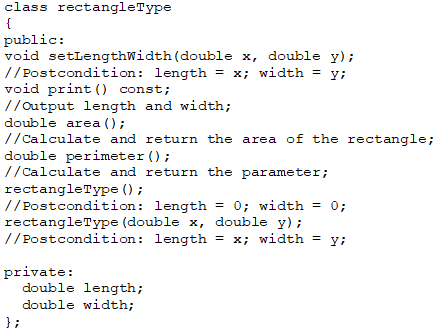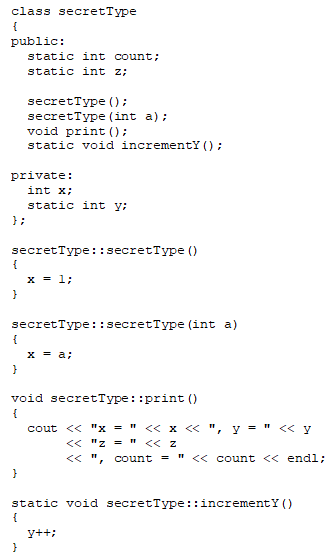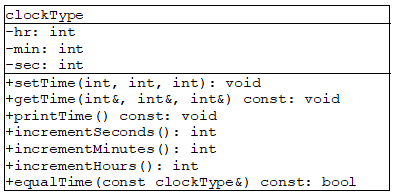A) static
B) automatic
C) local
D) public
F) B) and D)
Correct Answer

verified
Correct Answer
verified
Multiple Choice
How many destructors can a class have?
A) no explicit destructors
B) one
C) two
D) any number
F) B) and C)
Correct Answer

verified
Correct Answer
verified
Multiple Choice
A class and its members can be described graphically using a notation known as the ____ notation.
A) OON
B) OOD
C) UML
D) OOP
F) A) and B)
Correct Answer

verified
Correct Answer
verified
Short Answer
Non-static member variables of a class are called the ____________________ variables of the class.
Correct Answer

verified
Correct Answer
verified
Multiple Choice
What does ADT stand for?
A) abstract definition type
B) asynchronous data transfer
C) abstract data type
D) alternative definition type
F) C) and D)
Correct Answer

verified
Correct Answer
verified
Short Answer
A(n) ____________________ contains the definitions of the functions to implement the operations of an object.
Correct Answer

verified
implementation file
Correct Answer
verified
Multiple Choice
To guarantee that the member variables of a class are initialized, you use ____.
A) accessors
B) mutators
C) constructors
D) destructor
F) B) and C)
Correct Answer

verified
Correct Answer
verified
True/False
If the heading of a member function of a class ends with the word const, then the function member cannot modify the private member variables, but it can modify the public member variables.
B) False
Correct Answer

verified
Correct Answer
verified
Multiple Choice
 -Consider the accompanying class definition, and the declaration: rectangleType bigRect;
Which of the following statements is correct?
-Consider the accompanying class definition, and the declaration: rectangleType bigRect;
Which of the following statements is correct?
A) rectangleType.print() ;
B) rectangleType::print() ;
C) bigRect.print() ;
D) bigRect::print() ;
F) A) and D)
Correct Answer

verified
Correct Answer
verified
True/False
If an object is declared in the definition of a member function of the class, then the object can access both the public and private members of the class.
B) False
Correct Answer

verified
True
Correct Answer
verified
Multiple Choice
In C++, the scope resolution operator is ____.
A) :
B) ::
C) $
D) .
F) B) and C)
Correct Answer

verified
B
Correct Answer
verified
True/False
As parameters to a function, class objects can be passed by reference only.
B) False
Correct Answer

verified
Correct Answer
verified
Multiple Choice
A destructor has the character ____, followed by the name of the class.
A) .
B) ::
C) #
D) ˜
F) A) and C)
Correct Answer

verified
Correct Answer
verified
Multiple Choice
 -Consider the accompanying class and member functions definitions. How many constructors are present in the class definition?
-Consider the accompanying class and member functions definitions. How many constructors are present in the class definition?
A) none
B) one
C) two
D) three
F) A) and D)
Correct Answer

verified
Correct Answer
verified
Short Answer
A(n) ____________________ is a statement specifying the condition(s) that must be true before the function is called.
Correct Answer

verified
Correct Answer
verified
True/False
In C++, class is a reserved word and it defines only a data type.
B) False
Correct Answer

verified
Correct Answer
verified
Multiple Choice
Which of the following class definitions is correct in C++?
A) ![]()
B) ![]()
C) ![]()
D) ![]()
F) B) and D)
Correct Answer

verified
Correct Answer
verified
True/False
You can use arithmetic operators to perform arithmetic operations on class objects.
B) False
Correct Answer

verified
Correct Answer
verified
Multiple Choice
 -Consider the UML class diagram shown in the accompanying figure. According to the UML class diagram, how many private members are in the class?
-Consider the UML class diagram shown in the accompanying figure. According to the UML class diagram, how many private members are in the class?
A) none
B) zero
C) two
D) three
F) B) and C)
Correct Answer

verified
Correct Answer
verified
Multiple Choice
The components of a class are called the ____ of the class.
A) elements
B) members
C) objects
D) properties
F) B) and C)
Correct Answer

verified
Correct Answer
verified
Showing 1 - 20 of 43
Related Exams